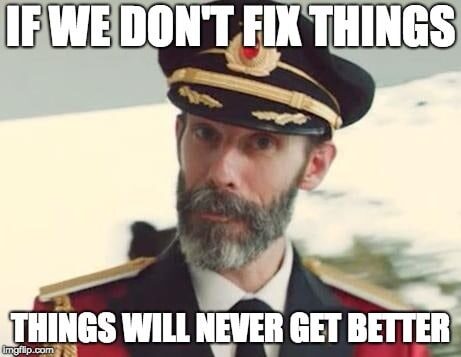When coaching people in healthcare, I often find myself saying something about the role of leaders in creating systems that meet the needs of patients and staff.
Hear Mark read this post — subscribe to Lean Blog Audio
I was reminded of a post from this week four years ago, where I went through notes from a 2007 Lean healthcare conference, where John Shook said:
People should be “comforted and supported by the system”
A variation on this theme comes from Darril Wilburn, a former Toyota leader I know from San Antonio:
“It's the responsibility of leadership to provide a system in which people can be successful.”
We see the influence the late W. Edwards Deming had on Toyota. Deming said “quality is made in the boardroom” and he taught that senior leaders are responsible for the system. People can only perform within the bounds of a system. Each system is perfectly designed to get the results it gets. We learn this from the Red Bead Experiment (and from the world around us, if we pay attention).
Too often, I see leaders pressuring staff to do better… asking them to work harder in a fundamentally broken system. As powerful as small-scale staff-driven “Kaizen” can be, you can only get so far by continuously improving a system that needs to be completely redesigned.
I recently saw a surgeon's valid complaint on LinkedIn, as you can see in this post (and the discussion that follows):
He wrote:
“Had a big case scheduled for mon (approx 3-4 hrs long). Patient is in a nursing home.
Nursing home never did any of the pre op labs or tests so had to cancel the case.
Now there's a big gaping hole in the OR schedule and all the patients that could have had surgery during that time can't and all the implants and instruments that were ordered are now sitting idle.
No repercussions or accountability, just pure waste.
I think sharing in risk/bundles will help align the stakeholders and incentivize people to pay attention.”
It sounds pretty factual for him to point out there is waste there. Idle time, delays, etc. That's something that a healthcare organization should work to address.
I notice that Dr. Dasa is blaming a different organization. Many of our healthcare “value streams” (or we could call them end-to-end patient journeys) go across organizational boundaries and silos. There are often disconnects and problems that occur even when different silos are in the same building and under the same organizational banner.
Without talking about WHY these problems occurred, it's interesting to me that Dr. Dasa suggests “repercussions or accountability” as countermeasures.
It sounds like he means punishing somebody (or threatening punishment).
Many of the LinkedIn comments talked about blame and “accountability,” including:
- “If you want them to have accountability, ask someone in your office to report them… CYA”
- Blaming misaligned incentives
- Calling for “painful regulatory consequence for the long term care facility for not getting up off their rear ends” (as if the LTC facility is being lazy)
- “why didn't you hold your own office accountable to ensure the proper pre testing was completed earlier in the week?”
- “Your surgery scheduler should have caught that.”
That prompted me to write this, also on LinkedIn:
It's amazing how many people still think punishing individuals leads to quality improvement. If that were true, healthcare would be pretty much perfect by now. Punishment leads to fear, hiding of problems, deflection of blame – which doesn't lead to improvement.
The norm in healthcare has been “naming, blaming, and shaming.” Those behaviors haven't fixed healthcare.
I asked Dr. Dasa a question in response to his post:
“Dr. Dasa, what did you or one of your team members do to follow up with the nursing home or your staff to understand the root cause of the problem?”
I don't mean that I expected him to fix it. But, he's at what Toyota might call the “point of occurrence.” He's observing and detecting the problem. He or his staff should have a channel and a mechanism for REPORTING the problem. It would be the equivalent of a Toyota assembly line worker “pulling the andon cord” when there is a problem.
At a Toyota plant, pulling the cord (or pushing a button) leads to an almost-immediate response. There's a team leader and, if needed, other people available to help improve the process. They'd work to understand WHY the problem occurred (instead of asking WHO messed up) and they'd work to improve the process in a way that prevents future problems).
Some healthcare organizations have internal “Lean teams” or process improvement facilitators who can help in such situations.
But, improvement won't happen without:
- A way to speak up
- A timely, helpful response
- Improvement coaches (to help, not take away responsibility for improvement)
- Freeing up time for healthcare professionals to participate in improvement work
Dr. Dasa replied… what did he do?
“nothing. We're swamped managing the next 50 patients who also need our undivided attention. Have a number of mri's, labs, surgeries… we're trying to keep on track”
Like I said, I don't expect Dr. Dasa to fix the system. But, it seems clear that nobody is asking him to speak up about such problems that affect him and his patients. He took to venting on LinkedIn, which doesn't really fix anything.
Somebody asked if there was a root cause analysis being done. Dr. Dasa said:
“Doubtful, too much other stuff we have to worry about. Unless there's direct harm and risk for a lawsuit, no motivation for RCA. We've already moved on to the dozens of other surgeries we need to get cleared.”
The situation reminds me of this expression (it's a thought I learned from others):
You get what you expect and you deserve what you tolerate. -Mark Graban
— Black Thought (@blackthought) July 5, 2013
When organizations tolerate waste like this, they're going to get more of it.
Dr. Dasa also added:
“I won't get tired (not yet) of complaining because the only way to fix it, is to bring it to light.”
I'm not sure bringing the problem “to light” always leads to fixes. Complaining on LinkedIn doesn't help. It's sad that he might not get a helpful response if he raised the issue internally.
This whole discussion made me think of something Captain Obvious might say in a commercial:

Again, this isn't Dr. Dasa's fault. His organization and his leaders seem to be failing him. He said:
“We have process improvements up to our eyeballs. I can't keep track the flavor of the day hospital process improvement/QI initiative we have going on.”
But are these efforts effective? If so, are there just too many problems to solve all at once?
Thinking back to the Wilburn quote, is management creating a system in which Dr. Dasa can be successful? In Shook's words, is the system “comforting and supporting” him and his patients?
Postscript: Our friend and “Toast Guy” Bruce Hamilton (a.k.a. “Old Lean Dude”) wrote a post about his recent time in the hospital:
It's a great blog post, with examples of how problems get normalized instead of getting fixed… and that's not the fault of the caregivers.
Bruce ends the post with wise words:
“Your caregivers are your most valuable resource. Management's job is to create an environment in which the ‘things that get in the way of the work' are exposed and corrected, enabling caregivers to fulfill their missions with more time and greater focus on making the patient well.”
Check out the post.
Please scroll down (or click) to post a comment. Connect with me on LinkedIn.
Let’s build a culture of continuous improvement and psychological safety—together. If you're a leader aiming for lasting change (not just more projects), I help organizations:
- Engage people at all levels in sustainable improvement
- Shift from fear of mistakes to learning from them
- Apply Lean thinking in practical, people-centered ways
Interested in coaching or a keynote talk? Let’s talk.
Join me for a Lean Healthcare Accelerator Trip to Japan! Learn More










The discussion on LinkedIn continues:
I believe that we now know enough about leadership in the context of both classical management practice and Lean management practice to say this: Leaders of the classical management variety believe that people (employees) must support the leaders – not the other way around. That is a traditional “standard,” one that is largely unchanged when corporate leaders adopt Lean. As we all know, there are those few cases where leaders recognize the role is largely flipped in Lean management practiced correctly. Unfortunately, we have been unable to create a new “standard” after 30 years of effort, and, based on my recent work, there appears to be no clear path for doing so.
An experiment with a video version of the blog post:
Comments are closed.